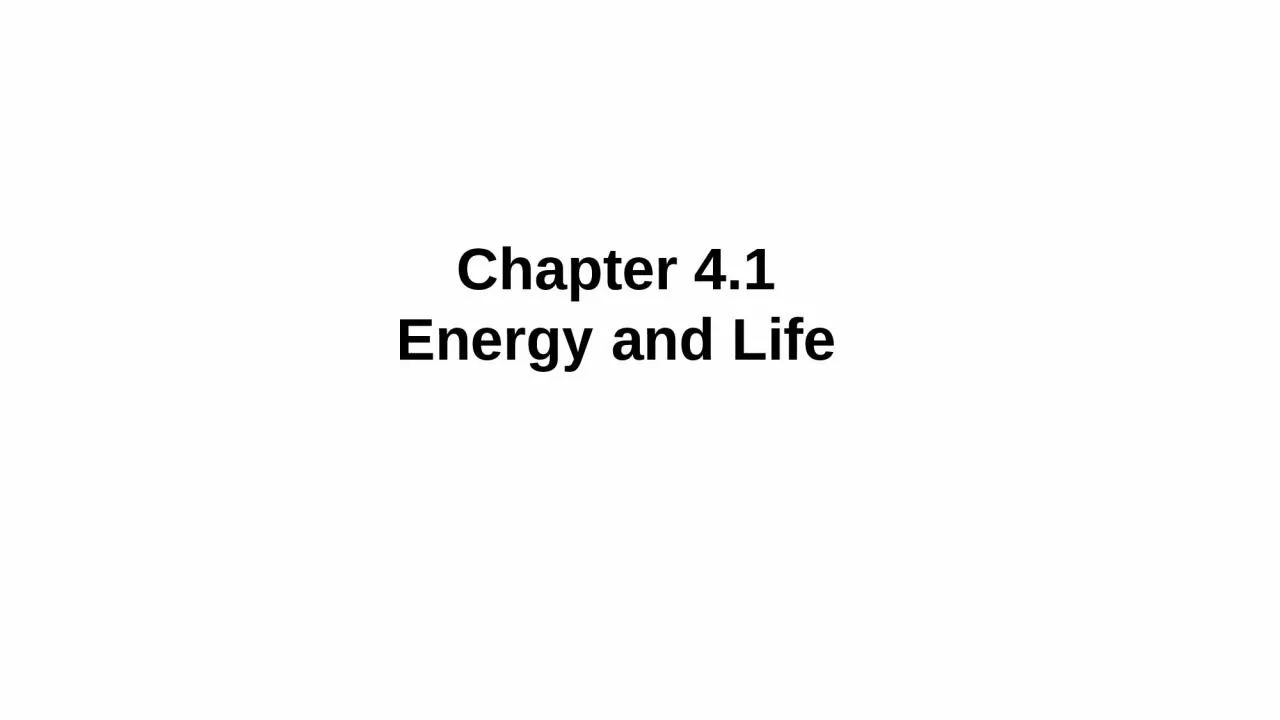

What is energy Energy is the ability to do work Energy Sunlight is the main energy source for life on Earth 1 Cells use chemical energy in the form of a chemical compound called ATP or adenosine triphosphate ID: 1033188
Download Presentation The PPT/PDF document "Chapter 4.1 Energy and Life" is the property of its rightful owner. Permission is granted to download and print the materials on this web site for personal, non-commercial use only, and to display it on your personal computer provided you do not modify the materials and that you retain all copyright notices contained in the materials. By downloading content from our website, you accept the terms of this agreement.
1. Chapter 4.1Energy and Life
2. What is energy?Energy is the ability to do work!
3. EnergySunlight is the main energy source for life on Earth.
4. 1. Cells use chemical energy in the form of a chemical compound called ATP, or adenosine triphosphate. a. ATP contains: i. A 5-carbon sugar called ribose ii. A nitrogenous base called adenineiii. Three phosphate groups b. The bonds between the phosphate groups store and release energy
5. phosphate removedATP transfers energy from the breakdown of food molecules to cell functions.Energy is released when a phosphate group is removed.ADP is changed into ATP when a phosphate group is added.
6. The chemical energy used for most cell processes is carried by ATP. Molecules in food store chemical energy in their bonds.Starch moleculeGlucose molecule
7. 3. ATP is the basic energy source of all cells
8. Organisms break down carbon-based molecules to produce ATP.Carbohydrates are the molecules most commonly broken down to make ATP.not stored in large amountsup to 36 ATP from one glucose moleculetriphosphateadenosineadenosinediphosphatetri=3di=2
9.
10. ADPATPEnergyEnergyAdenosine diphosphate (ADP) + Phosphate Adenosine triphosphate (ATP)PartiallychargedbatteryFullychargedbattery c. ATP is like a rechargable battery.
11. Chemical Energy and ATP: Storing EnergyEnergy is stored in ATP a. ADP, adenosine diphosphate, is similar to ATP but has two phosphate groups instead of three b. When a cell has energy available, it can store small amounts by adding a phosphate to ADP making ATP
12. Using the energy1. When a chemical bond between the 2nd and 3rd phosphates of ATP is broken, energy is released
13. Chemical Energy and ATP: Releasing Energy2. ATP has enough energy to power a variety of cellular activities A. active transport across the selectively permeable cell membrane B. protein synthesis C. muscle contractions D. Propels flagella E. Produces light in firefliesFireflyEscherichia coli bacterium with flagella
14. 4. ATP is a good short term energy storage that is recycled between ADP and ATP. Cells have only a small amount of ATP.It is more efficient for cells to store energy as glucose.When cells need energy they make ATP from ADP using energy from glucose.
15. Fats store the most energy.80 percent of the energy in your bodyabout 146 ATP from a triglycerideProteins are least likely to be broken down to make ATP.amino acids not usually needed for energyabout the same amount of energy as a carbohydrate
16. ADP vs. ATPhttp://www.phschool.com/atschool/phbio/activities/cbd-3081/simbase.htm
17. What is the name of the molecule above?What is the name of the part of the molecule labeled:A? ___________________________B? ___________________________C? ___________________________ABCadenineribose3 phospates
18. How does a cell get energy from this molecule?ABCBy breaking the bond between the 2nd and 3rd phosphate. This releases the energy!!